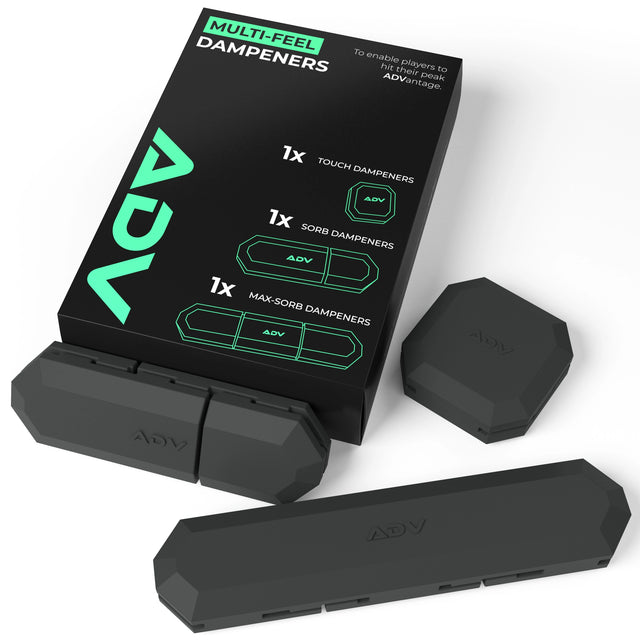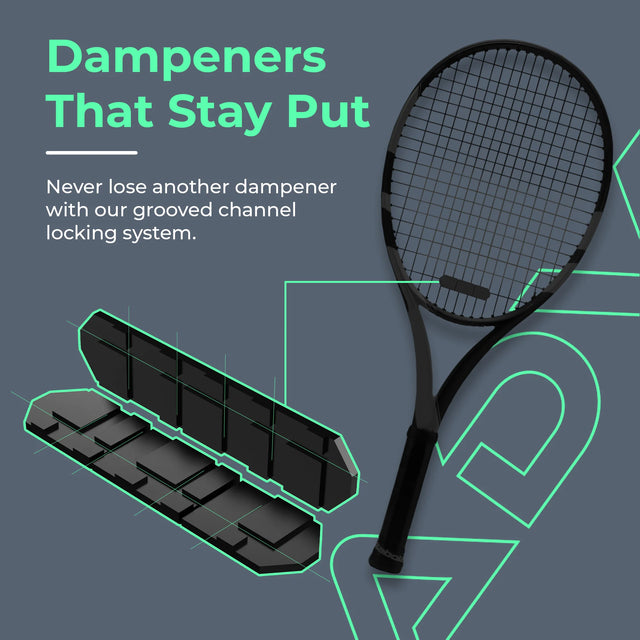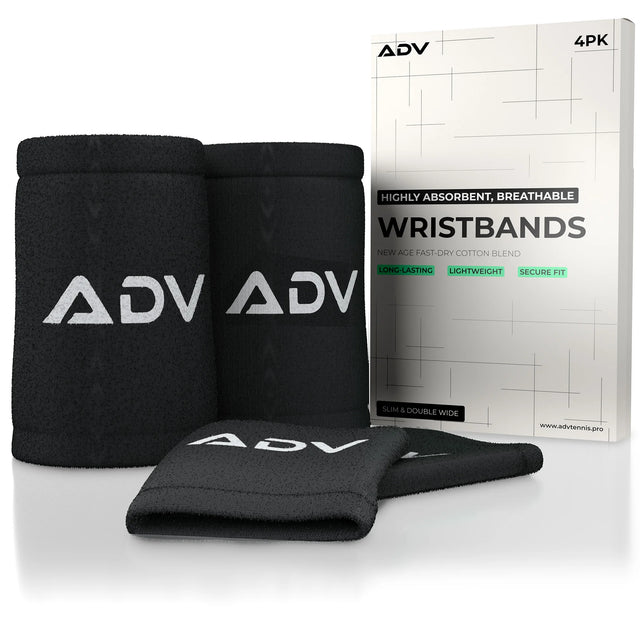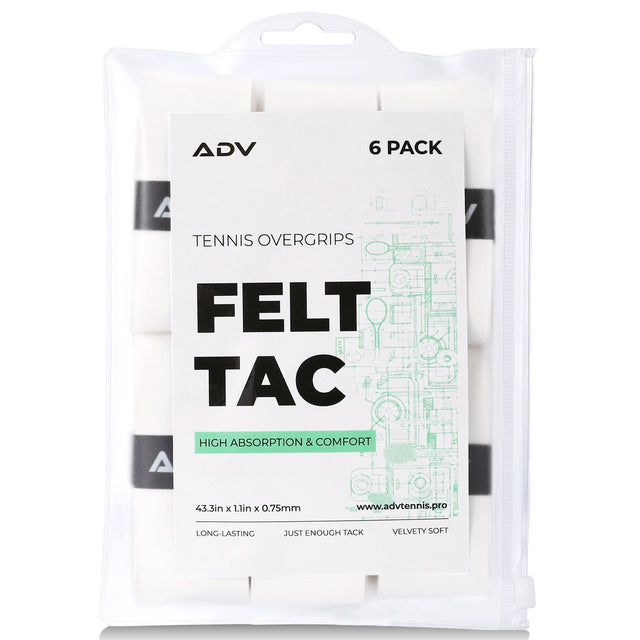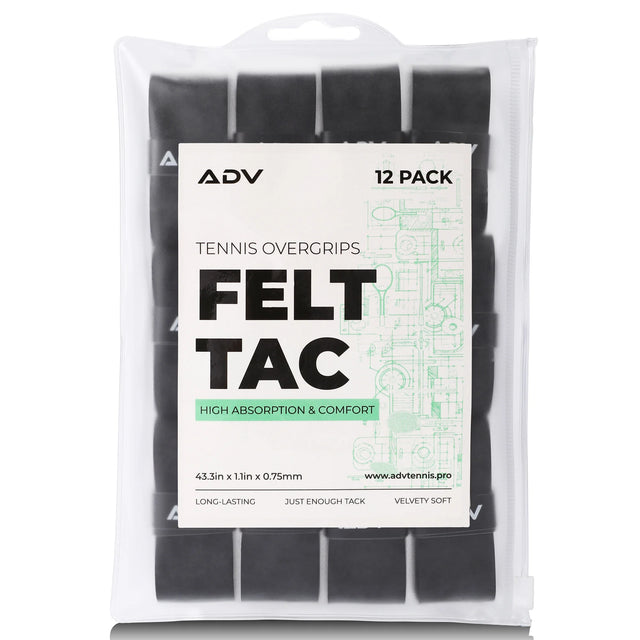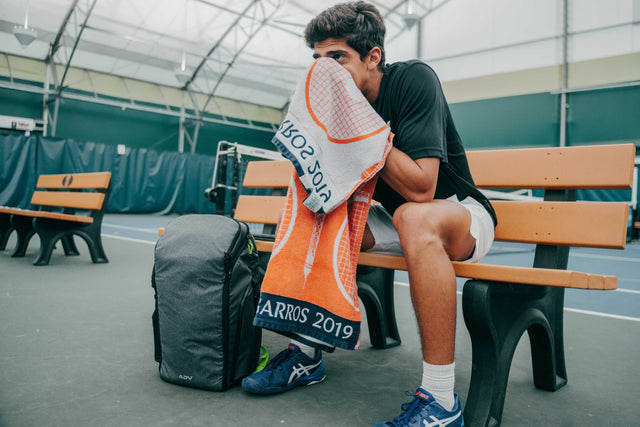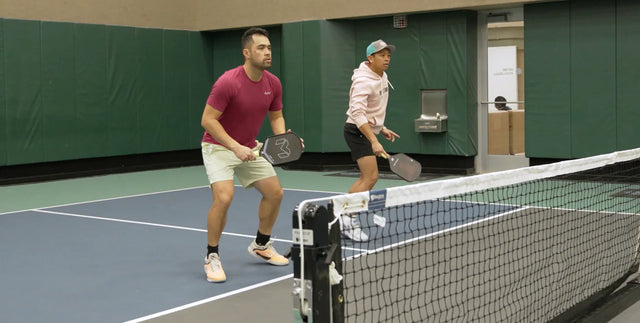Tennis Wristbands: How They Improve Grip and Sweat Control
Tennis is a fast-paced game that demands quick movements, intense focus, and a strong grip on the racket. Controlling sweat and maintaining wrist stability are key to consistent performance for many athletes. This is where wrist support for tennis players becomes so important. Tennis wristbands are not just an accessory—they help absorb sweat, prevent slipping, and keep your hands dry while playing. Whether you are practicing for long hours or competing in a match, wristbands serve as a barrier against moisture, helping to keep your grip steady. They are designed to reduce distractions caused by sweat dripping onto your hands, allowing you to stay concentrated on your technique and movement throughout the game.
How Tennis Wristbands Improve Grip and Performance
Preventing Slippage
A secure grip on the racket is one of the most important elements in tennis. Without it, even well-practiced swings can lose their power and direction. The best wristbands for athletes are designed to prevent slippage by keeping sweat from interfering with your grip. As you move across the court, your body generates heat and moisture, which can cause your hands to become slippery. Wristbands absorb this moisture before it affects your hold on the racket handle. This helps maintain a steady grip even during long matches.
Enhancing Energy Transfer for More Powerful Shots
The strength and control of each shot in tennis depend on how well your body transfers energy through the racket. The benefits of tennis wristbands include helping players keep their hands dry and stable, which supports the transfer of energy. When sweat interferes with your grip, it can absorb some of the force intended for the ball, weakening your shots. By managing moisture effectively, wristbands ensure that energy is not lost through slippage or poor hold.
Reducing Hand Fatigue
Extended practice sessions and competitive matches can put a significant strain on your hands and wrists. Over time, this strain can lead to discomfort or even injury if not properly managed. Wearing a wrist guard for tennis helps ease this stress by offering additional support to the wrist area. It reduces unnecessary muscle tension in the hands and forearms. A relaxed grip helps prevent fatigue, allowing you to sustain energy for longer periods.

Advanced Sweat Control and Moisture-Wicking Technology
Moisture-Wicking Fabrics
Many modern designs incorporate advanced materials that feature moisture-wicking properties. These fabrics are designed to draw sweat away from the skin and spread it across the surface of the material for faster evaporation. This feature is one of the standout qualities of tennis wristbands for comfort because it helps keep the skin dry without the need for frequent wiping. Moisture-wicking fabrics are often lightweight, soft, and breathable, making them comfortable for extended wear. They also help reduce irritation that might occur when sweat remains trapped against the skin.
Preventing Distractions
In the middle of a fast-paced game, distractions caused by sweat can easily break your concentration. A drop of moisture running down your arm or pooling on your hand may force you to stop, wipe down, or readjust your grip. This breaks your rhythm and can disrupt your flow of play. Tennis sweatbands help prevent these issues by managing moisture before it becomes a problem. With effective sweat control, your hands stay drier, reducing the need for mid-game adjustments.
Comparing Different Materials
The effectiveness of tennis wristbands greatly depends on the materials used in their construction. When choosing custom tennis wristbands, understanding the differences between available fabrics can help you select the option that offers the best sweat absorption and comfort for your playing style. Below are the key materials commonly used:
- Cotton: Renowned for its natural origin and exceptional absorbency, cotton wristbands excel at capturing high volumes of perspiration, making them a favorite among players who generate considerable sweat during intense rallies. The thick, looped terry construction typical of cotton bands creates an extensive network of fibers that traps moisture against the surface, rather than letting it drip, which helps keep grips dry and reduces slippage. This same plush texture provides a gentle, cushioning effect around the wrist, enhancing comfort during long matches. However, when saturated, cotton can become noticeably heavier and feel waterlogged, potentially causing dragging or uneven pressure. Its slow drying rate means that moisture lingers unless bands are rotated or laundered frequently—a factor to consider for multi‑session players.
- Polyester: This brings remarkable moisture‑transport properties that wick liquid away from the skin and spread it across the outer fabric layer for rapid evaporation. Its engineered capillary action means that polyester wristbands rarely feel soaked, even during extended practice sessions or competitive matches in humid climates. Their lightweight construction minimizes any sensation of bulk, and the material’s quick‑drying nature ensures that bands return to a near‑dry state within minutes of brief air exposure. Polyester inherently resists mold and mildew growth, a welcome advantage for players who stow damp gear between sessions. The fabric also retains its shape and vibrant colors through hundreds of washes, thanks to its minimal shrinkage and strong fiber bonds. On the downside, polyester can sometimes retain odors more stubbornly than natural fibers, necessitating periodic deep cleaning or the use of specialized detergents to avoid musty smells. It may also feel less plush against the skin, offering a firmer texture that some users find less cushioned.
- Nylon: The polymer structure of nylon provides outstanding tensile strength and abrasion resistance, making wristbands constructed from it highly resilient to friction, snagging, and the day-to-day wear of competitive play. While pure nylon does not absorb sweat as aggressively as cotton, its hydrophilic variants—often branded as “micro‑nylon”—draw moisture into the fibers and then release it quickly, avoiding the waterlogged sensation of heavier bands. This faster drying time contributes to a more consistent level of comfort throughout successive games. Nylon’s smooth surface also glides easily under clothing cuffs, reducing pinching or bunching that can interrupt focus. Against the skin, it offers a sleek, slightly silky feel that some players appreciate for its minimal drag.
- Spandex or Elastane Blends: Known primarily for their exceptional elasticity, spandex (also marketed as Lycra or elastane) fibers are rarely used alone but instead incorporated into wristband fabrics to provide stretch, recovery, and tailored compression. When blended with cotton or polyester, spandex ensures that the band conforms snugly to the wrist’s contours, preventing slippage even during rapid movements or changes in direction. This elasticity maintains consistent contact between the absorbent fibers and the skin, enhancing overall sweat capture and distributing moisture evenly throughout the band. The elastic core also helps the wristband spring back to its original shape after each wear, countering fabric fatigue and sagging. For players with joint sensitivity or those who prefer a gentle compression feel, spandex-infused bands can provide light support that reduces muscle vibration and perceived strain. However, because spandex itself contributes little to moisture absorption, the overall performance rests on the companion fabric’s wicking or soaking properties. Also, high spandex concentrations may slightly elevate the band’s temperature retention, making them feel warmer in hot conditions. Despite these considerations, blends with 5–15% spandex deliver an ideal balance of flexibility, fit retention, and enhanced moisture channeling, making them indispensable components of modern athletic wristbands.
- Microfiber: Engineered from ultra-fine synthetic strands—often polyester or polyamide—microfiber wristbands utilize their high surface-area-to-volume ratio to manage moisture with precise accuracy. The tiny filaments create microscopic capillaries that rapidly draw sweat away from the skin into the band’s interior, then diffuse it across a broad area for accelerated evaporation. This rapid wicking keeps the skin incredibly dry, even during prolonged rallies or high‑intensity drills. Unlike traditional cotton towels, microfiber feels exceptionally soft and light, virtually disappearing on the wrist while still performing aggressive moisture control. It also resists snagging and abrasion, maintaining a sleek appearance over extended use. Because the fibers are so delicate, they compress densely, creating a barrier that blocks liquid from seeping through to clothing, yet allows air to circulate for thermal regulation.
Each material serves a specific purpose, and the best choice depends on your preferences for feel, absorption, and drying speed. Understanding these differences helps ensure that the wristbands you choose meet your personal needs on the court.

Design, Fit, and Comfort Considerations
Ergonomic Construction
When selecting men's tennis wristbands, how they fit your wrist is just as important as their ability to control moisture. A well-designed wristband should feel snug yet not restrictive, allowing for a full range of motion while remaining securely in place. Ergonomic construction focuses on shaping the wristband to follow the natural contour of the wrist and forearm. This design helps prevent the band from slipping or twisting during play. A flexible wristband allows for comfortable wear without digging into the skin or causing discomfort. The balance between firmness and flexibility supports wrist stability, ensuring the band performs well without interfering with hand movements.
The Importance of Non-Restrictive Wristbands
Comfort during gameplay relies on using equipment that supports movement without adding unnecessary weight. Tennis wrist support products should be lightweight enough to avoid becoming a distraction while providing the necessary functions of sweat absorption and grip assistance. Heavier materials may feel bulky and uncomfortable, especially during quick, repetitive wrist movements. Lightweight wristbands minimize the sensation of added pressure on the arm, enabling players to concentrate solely on their performance.
Customization Options
Personal expression on the tennis court is not limited to clothing alone—wristbands offer a subtle yet effective way to showcase individuality. Choosing to purchase tennis wristbands with customization options enables players to express their style.
- Color Selection: Choosing the right hue for your wristband goes beyond matching your racket or outfit—it influences visibility, mood, and brand cohesion. Many suppliers offer a spectrum from crisp neutrals like ivory and charcoal to vivid statements such as flamingo pink or electric lime. When selecting a base shade, consider both your team's palette and how contrasting colors perform under different lighting conditions—bright tones stand out on television broadcasts, while darker shades can mask residual sweat stains during long tournaments. Advanced dyeing techniques, such as reactive or pigment dye, ensure deep saturation that resists fading, even after repeated washing and extended sun exposure. For players who switch gear frequently, dual-tone or ombré options allow for seamless integration with multiple uniform variations. Some manufacturers support Pantone matching services, allowing you to upload a brand’s precise color code so that every band aligns perfectly with logos, apparel, or sponsor imagery. Additionally, reflective or neon variants improve low-light visibility for evening matches or twilight practice sessions.
- Logo Embroidery: Embroidered logos turn a simple wristband into a mobile billboard for your personal brand, team name, or corporate sponsor. The process begins with digitizing your artwork into a stitch map, defining thread paths and densities that translate vector files into tactile embroidery. High‑density stitching yields crisp outlines for small text or intricate icons, while looser, fill‑stitch patterns allow for subtle shading effects. Suppliers often offer a choice between polyester threads—valued for their colorfastness and UV resistance—and rayon threads, prized for their sheen and soft drape. Specialty techniques, such as 3D puff embroidery, lift elements off the band surface, creating a sculpted effect that catches the light and draws attention. Strategic placement is crucial: centering a logo above the wristbone maximizes visibility during racket swings, whereas side‑panel embroidery offers a more discreet accent. To preserve clarity, maintain a minimum logo size—typically 0.75 inches square—so stitches don’t merge over time.
- Patterned Designs: Moving beyond solid colors, patterned wristbands infuse energy and movement into your look. Knitted jacquard designs interweave colored yarns to create durable, fade-resistant patterns that maintain their crispness through countless washes and wear. Sublimation printing, on the other hand, dyes the fabric at a molecular level, allowing for vibrant full‑color graphics. Paying attention to repeat size and orientation ensures the design wraps seamlessly around the wrist.
By taking advantage of these customization features, tennis players can enhance their gear both functionally and visually, making each match feel personal and empowering.
Maintenance and Durability of Tennis Wristbands
How to Properly Wash and Care
Understanding how to clean tennis wristbands ensures they remain effective at absorbing sweat and providing comfort throughout their use. After each match or practice session, wristbands often accumulate dirt, oils, and bacteria, which can lead to unpleasant odors and decreased performance if not cleaned regularly. Hand washing in mild detergent and warm water helps preserve the fibers and maintain their elasticity. For machine washing, it’s best to place wrist wraps for tennis elbow in a protective mesh bag to avoid excessive stretching or snagging. Allowing the bands to air dry instead of using a dryer prevents damage from heat exposure.
Antimicrobial Treatments
Many durable tennis wristbands now incorporate antimicrobial treatments that help reduce this problem by preventing bacterial growth on the fabric. These treatments work by inhibiting the growth of microbes that cause unpleasant odors, keeping the wristbands fresher between washes. Such features are especially helpful for athletes who engage in daily training sessions and may not always have the opportunity to wash their gear immediately after use.

When to Replace for Optimal Effectiveness
Knowing when to replace wristbands is crucial for maintaining your gear's optimal performance. Even the best tennis wristbands for sweat control will eventually show signs of aging after repeated use. When they become loose, lose their stretch, or no longer absorb moisture efficiently, they stop providing the necessary support and sweat control that players rely on.
Every player has their own approach to the game, and equipment should reflect those individual needs. The choice of material, fit, and design plays a role in how well premium tennis wristbands perform for your style of play. Understanding what feels right for your wrist size, sweat levels, and comfort preferences helps you select the gear that supports your best performance. You can move confidently through each game when you know that your equipment is helping you stay at your best.


